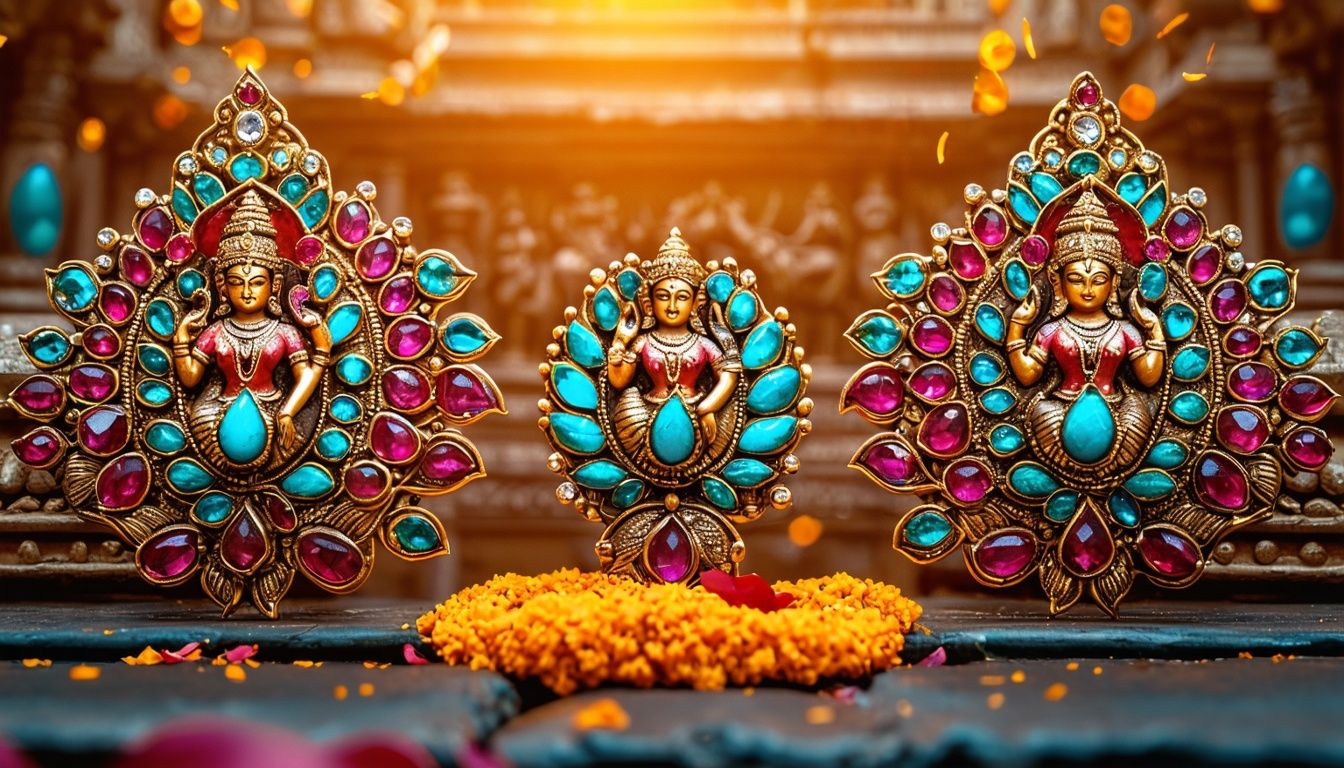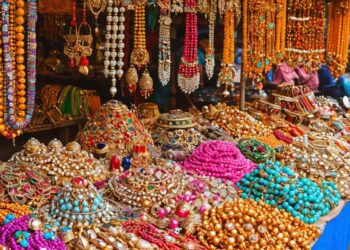Table of Contents
Choosing the right Indian jewellery can be confusing. One popular choice is antique temple jewellery. 2 This blog post will explore designs featuring Indian gods and goddesses, skilled artisans, and silk saree pairings. 3 Discover how temple jewellery elevates style. 1
01
of 10Key Takeaways
- Antique temple jewellery comes from deep roots in Indian culture, showing stories of gods and love for nature.
- This jewellery uses gold, silver, and precious stones to make special designs. Craftsmen work by hand to add delicate patterns.
- Modern styles mix old designs with new materials, making them fit today’s fashion.
- Temple jewellery is great for weddings and festivals because it adds beauty and meaning.
- Looking after these pieces keeps them shining. Store them right and clean gently.
02
of 10Significance of Temple Jewellery

Temple jewellery holds great significance in Indian culture, with its designs deeply rooted in symbolic motifs representing traditional beliefs and historical stories. The motifs are often inspired by deities, reflecting the cultural and spiritual values of the wearer.
Symbolic motifs and their meanings

Antique temple jewellery designs are rich in symbols. These include depictions of Indian gods and goddesses, animals, flowers, plants, and geometric shapes. 1 Each symbol has a deep meaning.
For example, the Om symbol is known for bringing good luck and spiritual protection. 1 Depictions of gods and goddesses show their qualities like strength, courage, and freedom. 2 This adds not just beauty but also value to the jewellery pieces.
Motifs in Indian jewellery do more than just decorate; they carry ancient stories and promises of protection.
Animals like peacocks symbolise immortality and renewal while flowers often represent purity and new beginnings. In these designs, even simple shapes hold great significance—circles for eternity, squares for stability.
By wearing such motifs in rose gold or silver antique jewellery, one embraces positive vibes meant to ward off negative energies as per traditional beliefs.
Cultural and historical relevance
Moving from the symbolic motifs, temple jewellery’s cultural and historical roots run deep. Craftsmen from Tamil Nadu and Kerala created these intricate pieces for ancient rituals. 3 Skilled artisans passed their knowledge through families, making each piece rich in tradition. This jewellery was first seen in temples but now shines on fashion stages worldwide.
Indian weddings and ceremonies showcase its beauty.
Temple jewellery’s designs tell stories of gods and goddesses, connecting wearers to their heritage. 4 Techniques like filigree work add detail to gold and silver, while precious stones bring colour.
Each piece is a blend of history and artistry, showing the skill of Indian jewellers over centuries. Wearers keep traditions alive, bridging past with present in style.
03
of 10Popular Designs in Temple Jewellery

Temple jewellery is known for its intricate designs and symbolic motifs that hold cultural significance. It commonly features motifs like Goddess Lakshmi and peacocks, adorned with Kemp stones and Nagas work, representing prosperity and beauty.
These designs are crafted using traditional techniques to create stunning pieces of jewellery that hold deep meaning in Indian culture.
Goddess Lakshmi and Peacock motifs
Goddess Lakshmi motifs in Indian jewellery bring blessings and prosperity to those who wear them. These designs show the goddess of wealth, often made from gold or silver, making them popular in bridal collections.

Peacock motifs add beauty and elegance, symbolising nobility. Jewellers craft these symbols into necklaces, earrings, and bangles for festive occasions.
Each piece tells a story of divinity, combining the grace of Goddess Lakshimi with the beauty of peacocks to create jewels that protect and adorn. 4
This unique blend makes each item not just an accessory but a bearer of good fortune and aesthetics. Whether cast in gold or encrusted with precious stones, these ornaments stand out in any celebration. 1
Kemp stones and Nagas work
Moving from the divine motifs of Goddess Lakshmi and peacocks, antique temple jewellery also shines with Kemp stones and Nagas work. Jewelers carefully embed these rich red stones into necklaces and pendants to add colour and life.
The intricate pattern known as Nagas work depicts mythical serpents, showcasing skilled craftsmanship. For instance, a notable piece like the Divine Lord Krishna Pendant Antique Nagas Necklace Set is available for ₹3,310. 5
Another example includes the Antique Nagas Kemp Stone Necklace Set priced at ₹2,270. These pieces highlight how Indian jewellery blends art with devotion, making each item more than just an accessory but a piece of heritage.
With prices ranging from ₹2,040 to ₹8,510, buyers can find something that suits their budget while owning a slice of India’s rich cultural tapestry. 4
04
of 10Materials Used in Temple Jewellery

Temple jewellery is typically crafted using traditional metals like gold and silver, often adorned with precious stones and pearls. The intricate detailing and craftsmanship involve handcrafted techniques, filigree work, and engraving to create these exquisite pieces.
Traditional metals like gold and silver
Gold and silver are key in making temple jewellery. Pure gold, sacred in Hindu culture, gets used often. 3 Silver and gold-plated pieces are modern twists. Craftspeople work with these metals carefully.
They add beauty to Indian jewellery by using skills like filigree work.
Craftsmen also put precious stones and pearls into the designs. These additions make each piece special for weddings and festivals. The use of these materials shows the rich history of temple jewellery. 4
Pure gold brings out the true essence of traditional Indian temple jewellery.
Use of precious stones and pearls
Temple jewellery often features precious stones like rubies, emeralds, and sapphires. These gems make the jewellery more beautiful. 4 Pearls are also used to add a touch of elegance and timelessness.
Precious stones and pearls bring out the richness in Indian jewellery designs, symbolising prosperity. Crafters include intricate patterns inspired by Hindu mythology in their work.
This makes each piece unique and full of meaning. Delicate filigree work adds to the ornate look of these designs. Next, we explore how handcrafted detailing plays a crucial role in creating temple jewellery. 6
05
of 10Crafting Techniques

Crafting antique temple jewellery involves intricate handcrafted detailing, using techniques like filigree and engraving to create elaborate designs. Skilled artisans meticulously work on each piece, ensuring that the traditional motifs are brought to life with precision and artistry.
Handcrafted detailing
Artisans use chiselling to carve intricate designs on gold and silver, creating stunning Indian jewellery pieces. 8 They pour molten metal into moulds for casting, shaping each piece with precision.
Cleaning and polishing follow, removing any impurities to reveal a gleaming surface. Setting colourful precious stones like diamonds and rubies adds beauty. These steps ensure temple jewellery is of the highest quality, resulting in unique items that shine.
Filigree work involves delicate silver or gold threads twisted into patterns, while engraving carves deep lines for decoration or text. Each technique contributes something special to the final look of antique temple jewellery. 7 Let’s move on to see how modern innovations influence these traditional designs.
Use of filigree and engraving
Transitioning from the intricate handcrafted detailing, antique temple jewellery often incorporates the use of filigree and engraving techniques to enhance its ornate beauty. Filigree involves delicately twisting thin metal threads, while engraving entails carving designs onto metal surfaces.
These techniques demand high skill and precision, resulting in unique and detailed pieces that hold cultural significance in Indian heritage. 9
These methods have been fundamental in creating the elaborate and symbolic motifs found in temple jewellery, adding a sense of timelessness and intricacy to each piece. The combination of filigree and engraving underpins temple jewellery’s long-standing history as well as its artistic craftsmanship, making it an integral part of traditional Indian jewelry. 10
06
of 10Modern Innovations in Temple Jewellery

Modern adaptations of temple jewellery often integrate contemporary materials, offering a fusion of traditional and modern elements. Designers have also adapted these timeless designs to suit modern wear preferences, making them accessible to a wider audience.
Integration of contemporary materials
Temple jewellery designs have evolved by integrating modern materials like silver, rose gold, and other non-traditional elements. This blend of tradition with contemporary materials adds versatility and appeal to traditional temple jewellery. 11
These innovative adaptations have been featured on fashion runways and are part of contemporary collections, reflecting a harmonious mix of tradition and modernity in Indian jewellery design.
The integration of these diverse materials has not only contributed to the aesthetic appeal but also expanded the scope for unique designs in temple jewellery. 12 It has broadened the range of options available for those seeking distinctive pieces rich in cultural significance.
Adapting designs for modern wear
Temple jewellery has evolved to suit modern styles. It incorporates contemporary materials, making it lightweight and versatile for everyday wear. Traditional motifs are reimagined with clean lines, lending a sleeker profile and delicate forms. 11
Popular designs like Goddess Lakshmi and Peacock motifs have been tailored to appeal to modern tastes, balancing tradition and personal style. The integration of floral motifs and contemporary lines ensures that temple jewellery blends heritage with current aesthetics seamlessly.
To cater to the ever-changing world of fashion, antique temple jewellery now offers adaptability while maintaining its historical significance. This includes not only bridal wear but also chic options for festive occasions, ensuring its relevance in today’s fashion scenes. 4
07
of 10Styling Temple Jewellery

When it comes to styling temple jewellery, think bridal wear and festive occasions. These pieces are a perfect match for traditional Indian attire and can enhance the overall look effortlessly.
Bridal wear
Temple jewellery is often worn by South Indian brides due to its cultural significance and traditional beauty. 13
The bridal necklace often features a pendant of Goddess Lakshmi, symbolising prosperity and divine blessings.
Earrings are crafted with peacock motifs, representing grace and elegance.
Brides adorn their hands with bangles embellished with Kemp stones and Nagas work, symbolising beauty and strength.
Many temple jewellery pieces incorporate gold and silver, along with precious stones and pearls.

Crafted using traditional handcrafted detailing, these pieces are designed to enhance the bride’s traditional attire. 14
Temple jewellery complements bridal wear, adding a touch of tradition and symbolism to the wedding ensemble.
Festive occasions
Temple jewellery is perfect for various festive occasions. It adds elegance and traditional charm to the overall festive attire, complementing solid colored outfits. Here are some instances where it can be worn:
- Diwali celebrations
- Akshay Tritiya festivities
- Wedding ceremonies
- Traditional dance performances
- Religious gatherings 4
These occasions provide a fitting setting for showcasing the timeless elegance of temple jewellery, making it an essential part of festive styling for many people. 15
08
of 10Maintenance and Care of Temple Jewellery

To keep temple jewellery in good condition, store it in a dry place away from direct sunlight to prevent tarnishing. Clean the jewellery with a soft cloth and avoid using harsh chemicals or abrasive materials that could damage the intricate designs.
Proper storage
- Store antique temple jewellery in individual compartments or pouches . 16
- Protect them from dust, moisture, and damage to prevent scratches and tangling .
- This practice is essential for maintaining their condition and beauty, ensuring their longevity .
- Proper storage practices are crucial, as they protect the jewellery from environmental factors that could cause deterioration over time . 17
Cleaning and handling
- Regularly clean temple jewellery with a gentle solution and a soft cloth. 17
- Handle the jewellery carefully to prevent damage to its intricate designs. 3
- It is recommended to have professional cleaning and inspection done regularly.
- Avoid exposing the jewellery to harsh chemicals and perfumes, as it can affect its appearance and longevity.
- Proper storage is essential for maintaining the beauty of temple jewellery.
- Regular maintenance is crucial for preserving the delicate detailing of the jewellery.
09
of 10Conclusion

Antique temple jewellery designs showcase symbolic motifs with cultural importance. Crafted using traditional metals and precious stones, these pieces feature intricate detailing and handcrafted techniques.
Modern innovations integrate contemporary materials, making them suitable for various occasions. Proper maintenance prolongs the beauty of temple jewellery, adding a touch of elegance to bridal wear and festive attire.
10
of 10FAQs
1. What are antique temple jewellery designs?
Antique temple jewellery designs are a type of Indian jewellery that reflects ancient traditions and craftsmanship.
2. How is antique temple jewellery distinct from other types of Indian jewellery?
Antique temple jewellery stands out due to its intricate designs, often featuring deities or motifs from nature, which aren’t commonly found in other types of Indian Jewellery.
3. Are there specific occasions where wearing antique temple jewellery is appropriate?
Yes, Antique Temple Jewellery is typically worn during traditional festivals and weddings due to its cultural significance and grandeur.
4. Can I find modern interpretations of antique temple jewellery designs?
Yes, many designers create contemporary versions of these classic Indian Jewellery pieces while maintaining the unique aesthetic characteristics that define them.
References
- ^ https://www.sayarjewellers.in/blog/the-symbolism-behind-temple-jewelry-designs
- ^ https://navrathan.com/temple-jewellery-set-art-of-uniqueness-and-symbol-of-tradition/
- ^ https://designerjwellery.medium.com/temple-jewellery-a-journey-through-history-and-evolution-5451c2cc72a9
- ^ http://iisjoa.org/sites/default/files/iisjoa/July%202022/32.pdf
- ^ https://www.sonalfashion.com/collections/antique-temple
- ^ https://www.michaelbackmanltd.com/archived_objects/south-indian-temple-jewellery-3/
- ^ https://theses.gla.ac.uk/318/2/2007pinckernellemphil.pdf
- ^ https://www.sayarjewellers.in/blog/the-art-of-temple-jewellery-making
- ^ https://www.researchgate.net/publication/362930600_Study_of_filigree_Traditional_metal_working_techniques_as_a_potential_craft_product
- ^ https://academicjournals.org/journal/JFSA/article-full-text-pdf/0CB2AA270072
- ^ https://medium.com/@devblkushals/contemporary-elegance-modern-interpretations-of-south-indian-jewellery-designs-e44a2b499749
- ^ https://www.researchgate.net/publication/316704605_THE_USE_OF_ALTERNATIVE_MATERIALS_IN_CONTEMPORARY_JEWELRY
- ^ https://www.vogue.in/fashion/content/everything-you-need-to-know-about-temple-jewellery-from-its-history-to-its-evolution
- ^ https://medium.com/@Misshighnessjewellry/the-role-of-temple-jewellery-collection-in-indian-weddings-7cc2ac0e7381
- ^ https://www.tarinika.in/blogs/news/how-to-style-temple-jewellery-for-different-occasions (2023-12-26)
- ^ https://vintagetom.co.uk/blogs/news/vintage-jewellery-care-tips (2023-10-24)
- ^ https://www.vummidi.com/blog/tips-for-caring-for-your-temple-jewellery/









